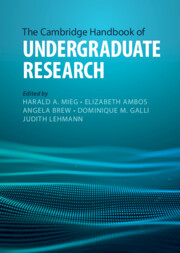Book contents
- The Cambridge Handbook of Undergraduate Research
- The Cambridge Handbook of Undergraduate Research
- Copyright page
- Contents
- Figures
- Tables
- Contributors
- Foreword
- Foreword
- 1 Introduction
- Part I Theory and Research on Undergraduate Research
- Part II Implementation, Approaches, Methods
- Part III Disciplines
- Part IV International Perspective
- 47 Introduction
- Part IV.1 Americas
- Part IV.2 Africa & Middle East
- 54 Undergraduate Research in South Africa
- 55 Undergraduate Research in Nigeria
- 56 Undergraduate Research in Israel
- 57 Undergraduate Research in the United Arab Emirates
- Part IV.3 Asia & Oceania
- Part IV.4 Europe
- Part V Avenues for Developing Undergraduate Research
- Index
- References
56 - Undergraduate Research in Israel
Educating STEM Students in Higher Education
from Part IV.2 - Africa & Middle East
Published online by Cambridge University Press: 11 August 2022
- The Cambridge Handbook of Undergraduate Research
- The Cambridge Handbook of Undergraduate Research
- Copyright page
- Contents
- Figures
- Tables
- Contributors
- Foreword
- Foreword
- 1 Introduction
- Part I Theory and Research on Undergraduate Research
- Part II Implementation, Approaches, Methods
- Part III Disciplines
- Part IV International Perspective
- 47 Introduction
- Part IV.1 Americas
- Part IV.2 Africa & Middle East
- 54 Undergraduate Research in South Africa
- 55 Undergraduate Research in Nigeria
- 56 Undergraduate Research in Israel
- 57 Undergraduate Research in the United Arab Emirates
- Part IV.3 Asia & Oceania
- Part IV.4 Europe
- Part V Avenues for Developing Undergraduate Research
- Index
- References
Summary
In this chapter, we briefly discuss the higher education system in Israel, its various types, and the settings of undergraduate studies at its universities. We then explain why we focus on universities with strong emphasis on science, technology, engineering, and mathematics (STEM) teaching and learning of undergraduate students. Finally, we explore several large-scale undergraduate research studies conducted at the Technion, the Israel Institute of Technology.
Keywords
- Type
- Chapter
- Information
- The Cambridge Handbook of Undergraduate Research , pp. 516 - 523Publisher: Cambridge University PressPrint publication year: 2022

